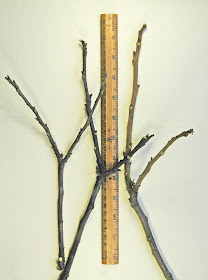Recently, I took a short drive down the gravel roads in the Neosho River bottom
to take a look at native pecan trees in mid-winter. I passed native groves that have had a history of
intensive management and then further down the road I came across groves that
receive minimal or no inputs during previous growing seasons. As I studied the canopies of native trees on
this cold clear day, I noted striking differences in branch structure between
well-managed and un-managed trees (photos below).
The first tree I
stopped at was located in a well manage native grove. What I mean by well
managed is that this native stand has received fertilizer applications, both
Fall and Spring, for well over 15 years. The grove is also sprayed regularly to
control pests and the ground cover is both grazed and mowed. Choosing a tree at
random within this grove, I looked upwards and photographed a portion of the
tree’s canopy (above right). Immediately, I
noticed the numerous shucks that still hung from the branches. This tree
produced a good crop of native nuts in 2016. But, I also noticed a vigorous
branching pattern. The twigs within the canopy were long, thick, and light grey
in color. This healthy growth pattern can only be appreciated after being
compared to the branches of an un-managed native pecan tree.
Down the road, I
came to one of those native pecan groves that suffer from a lack of attention.
If the trees in the grove look to be producing a few nuts, the orchard gets
mowed and raked just before the harvesters come in to collect a meager crop of
nuts. This grove has been starved of soil nutrients but is occasionally sprayed
for pecan weevil control. Again I picked
a tree at random and took a photo of the tree’s branch structure (above left). There was little evidence that this
tree produced a nut crop in 2016. The
tree had short, thin branches that appeared dark in color. In comparing the
canopies of managed and un-managed trees, it is almost hard to believe they are
both the same tree species.
After taking the
photographs of tree branch structure, I used a pole pruner to cut a sample of
twig growth from both trees (photo above). In the photo, the two dark twigs to the
left of the ruler came from the un-managed grove. To the right of the ruler, I
set down a single light-colored twig from the well managed grove. The reason I
photographed two twigs from the un-managed grove is to give you some idea how
poorly this tree bore nuts. Of the four terminals pictured from the un-managed
tree, only one terminal had a pedicel attached indicating the formation of a
nut cluster. Based on the size of the nut attachment scars on this one pedicel,
I guarantee that all the nuts in this cluster were aborted by mid-season due to scab
infection. In comparison, the branch from the well-managed tree displayed
prominent pedicels on both terminals.
This twig had borne two nut clusters in 2016.
But the twigs
pictured above have an even greater story to tell. Note the diameter of the shoot growth.
Un-managed twigs are thin and spindly. The twig cut from the managed tree has
shoots that are longer and thicker. And here’s why this all matters. I can look
at the branches of any native tree and predict its future productivity. Branch growth is a reflection of total tree
vigor. Vigorous thick shoots indicate that the tree will have the internal
reserves to produce an abundant pistillate flower crop in the Spring. Short, small-diameter twigs may produce a lot
of catkins but female flowers will few in number.
If you are still
grumbling about a poor crop in 2016, take the time to go out and look at your
trees this winter. If you don’t see vigorous branch growth, your native grove
is not on the path of good annual nut production. To increase annual nut production your first
step should be to apply enough nitrogen fertilizer to stimulate the growth of
strong, thick twigs. If the grove has been un-managed for several years, it
will take several years of annual fertilizer applications (both Fall and
Spring) to see a response from large native trees. Eventually, you’ll see
better shoot growth and subsequently much better nut production.

